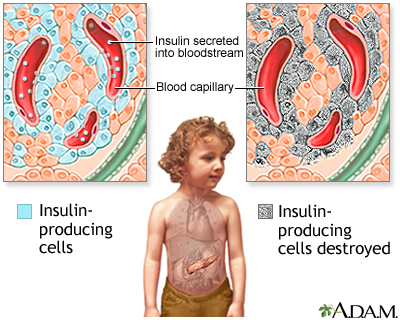Hope for New Diabetes Treatment
"We consider the research novel and an important step forward towards developing new therapies.""[Our research shows that a diabetic pancreas is] not incapable of producing insulin [their proof of concept addresses] unmet medical needs in Type 1 diabetes."Sam El-Osta, diabetes expert, Monash Department of Diabetes, Melbourne, Australia
Type 1 diabetes used to be referred to as Juvenile-onset diabetes. It is always insulin-dependent because the beta cells of the Isles of Langerhans located in the pancreas are destroyed in a presumed attack by the immune system erroneously; theoretically the result of the bodily entry of a foreign substance; for example a vaccine of some kind that provokes the body's immune system to attack, but it mistakes the beta cells for a foreign substance to be destroyed.
Until Banting and Best's discovery in a small makeshift laboratory at University of Toronto in 1921 of injecting missing insulin to achieve blood-glucose control by delivering blood-glucose to body cells, the diagnosis of diabetes onset for young people was a death sentence. They would simply waste away, the delivery of converted food sugars from the body's bloodstream by insulin to body cells to feed the brain and muscles gone completely awry.
Adult-onset diabetes (Type 2) on the other hand, was considered to be a lifestyle-disease, the result of sedentary practices and poor nutritional choices leading to overweight and the weakening of the production of insulin, usually treated by appropriate medication to tweak insulin production, unlike the more severe Type 1 for which multiple-daily insulin injections are required to maintain life. Both must test blood-sugar levels frequently to avoid both hypoglycemia and hyperglycemia. Both types have a genetic component.
In Canada alone, the Diabetes Canada group claims that one in three Canadians live with prediabetes or diabetes where the body is no longer capable of producing insulin, or is unable to properly utilize the insulin that is produced. That describes Type 2 diabetes. Chronic diabetes takes a dreadful toll on the body, even when the condition is under strict control through a combination of insulin injections, adequate exercise and an appropriate diet plan.
In the province of Ontario alone it is estimated that there are more people living with diabetes than elsewhere in Canada; rates of both Type 1 and 2 diabetes have risen by 42 percent in the last decade. The national economic burden for the treatment of diabetes is estimated at $30 billion in 2019, which represented an increase of $14 billion over 2009 figures.
 |
| Medline Plus |
Now a major breakthrough reflecting the results of new research out of Australia affecting both Type 1 and 2 diabetes promises to completely turn diabetes management on its head. The study reflects the discovery of a treatment that would replace insulin-producing cells in the pancreas. The study, published in the journal Signal Transduction and Targeted Therapy, saw researchers able to reactivate pancreatic stem cells from a Type 1 diabetic donor with the use of a drug approved by the U.S. Food and Drug Administration, not licensed for diabetes treatment.
The beta cells, upon reactivation, once again become capable of expressing insulin, functionally resembling the beta cells that produce insulin in non-diabetic people. The new therapy could one day -- according to the team behind the study -- allow insulin-producing cells destroyed in Type 1 diabetes to be replaced with new cells functionally capable of producing the same result.
Once it was believed that a diabetic pancreas was too damaged to be corrected. Now, although more research is required before the therapy can be applied to human subjects, the research team is optimistic about the potential for an entirely new game plan in responding to the chronic disease that threatens peoples' lives with the prospect of a reduced lifespan, an increased chance of diabetic retinopathy, amputations caused by nerve damage, heart failure, strokes and kidney failure.
| WebMD |
Labels: Research, Type 1 Diabetes, Type 2 Diabetes

0 Comments:
Post a Comment
<< Home